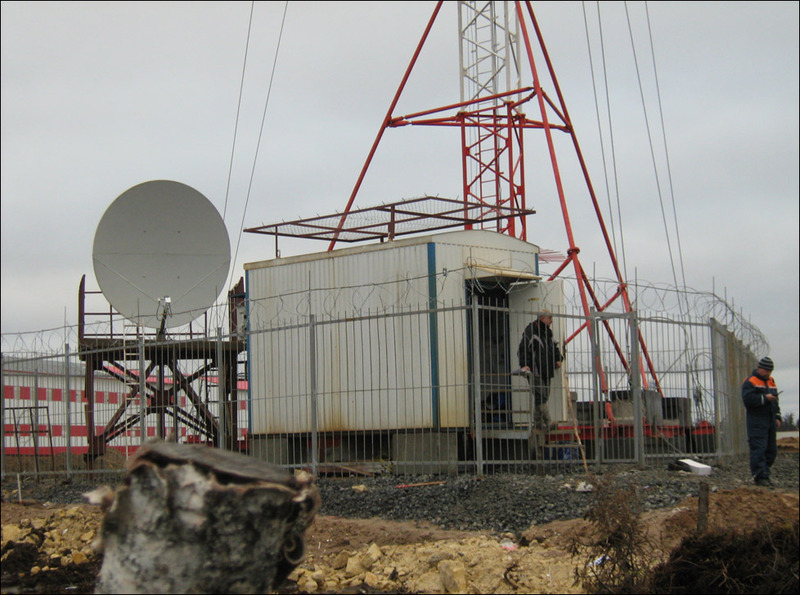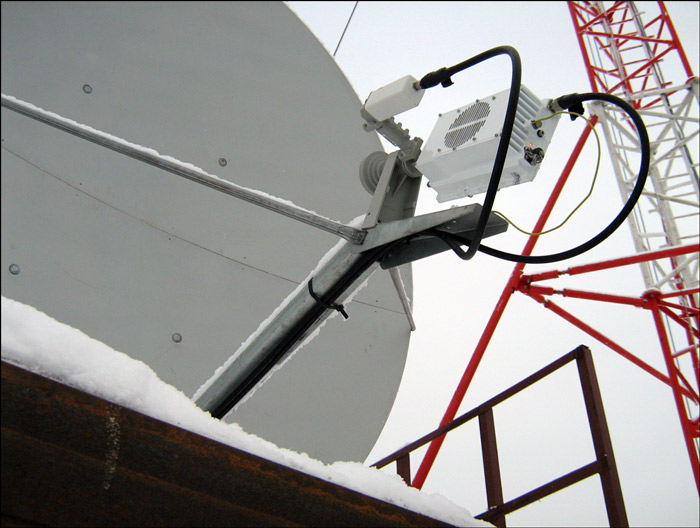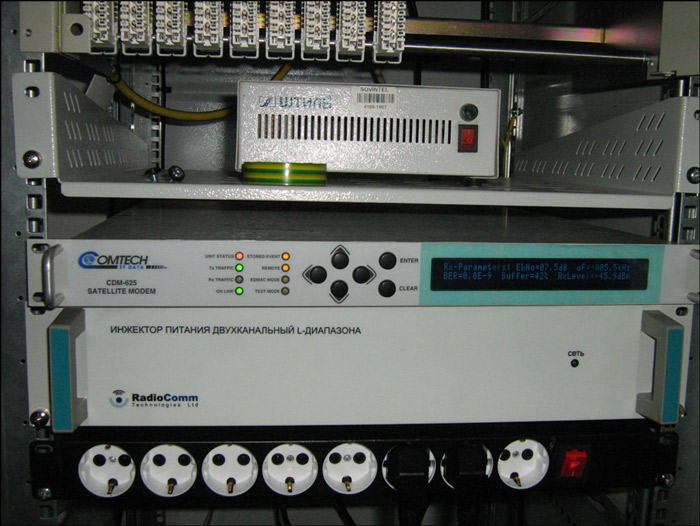How we made communication at the Mushroom Diamond Field
To the north-east of Arkhangelsk there is a diamond deposit of Grib , which employs several thousand people. There are no settlements as such in the region, only temporary houses with workers. And just these people need a connection in order to be able to talk with family or just go online for e-mail.
To place the base station, it was necessary to build such a tower. It has a cellular antenna and a piece of equipment: a

42-meter tower
Mast construction is the most expensive and longest stage of construction of a base station. Such a high mast - 42 meters - was needed in order to provide a fairly large territory with communications. The area is large, plus the complex relief of the field itself. The coverage area is 8-12 km. There are no immediate neighbors. Our nearest base station is over 150 kilometers away. The communication channel with the "large network" is satellite, the base station itself is of a distributed type.
It was difficult to build a tower not because of the winds, as you might think, but because of a bit of unusual logistics (sections had to be delivered to the area without normal roads), plus heaps of trouble with security - the facility was closed, it was necessary to build and launch the base station “ blindly. " Before us there was no connection.
After the construction of the mast, the ZSSS terminal was installed (satellite earth station, satellite dish, satellite receiver, transmitter) and a container in which the equipment was placed. The container is tight, air conditioners and a heating system are installed, everything works automatically.
The radiation power of the satellite transmitter is 4 watts, so you can’t stay in the antenna when the transmitter is on, you can already walk behind the antenna. The photo is not entirely obvious, but the container is in a safe area.

Satellite dish and equipment container
All consumers are connected to a high-voltage line, then a transformer substation is installed. The container is equipped with batteries in case of power failure. The base station is able to work on them for another 5 hours, in case of a long-term lack of electricity - we bring diesel generator sets and fuel.
ZSSS is required for communication of the base station with the BS controller located in Arkhangelsk and further with the switch. On the satellite channel, the E1 channel was raised at a speed of 2048 kb / s. One voice channel with Half Rate encoding takes 8 kb / s, so there is still room for mobile Internet traffic in the channel. The possibility of rebuilding a dish to another satellite is done by hand. The plate is well fixed and calibration is usually not required. In practice - if everything is set up correctly, then for at least five years you can not touch anything even with strong winds, it is only important to clean the snow.

A transmitter (large unit) and an LNA-low-noise amplifier of the receiving path (small) were mounted directly at the antenna of the SSSS. The photo shows the holes in the body - we close them with plugs in this object so that the snow does not get inside.

A Comtech satellite modem, an injector for powering the satellite transceiver, was installed in the container. The container maintains a temperature of about 23 degrees due to two air conditioners.
Nokia Flexi EDGE cellular base station equipment was also installed on the mast and container.
This type of base station is distributed, i.e. control unit and transmitters spaced. Now such a scheme is used at all new base stations to save electricity in the framework of the "green" project , but specifically at our installation it is also a necessity due to rather difficult weather conditions.
The control unit of the ESMB base station (installed in the container) is responsible for controlling the transmitters, storing and distributing software, raising the ABIS interface, via the satellite channel, to the base station controller.

ESMA connects to EXEA transmitters via a high speed optical data bus. EXEA are installed directly at the antennas, which avoids losses in the feeder path.

EXEA with open case cover.
Initially, one unit was supplied; it supports a configuration with three sectors of two frequencies in each sector with a radiated frequency power of 30 watts. The maximum number of simultaneously talking subscribers with this configuration is 84, which was not enough in the first month after starting the BS.
Now another EXDA block has been added to the BS, which allows the BS to cope with traffic without congestion. The radiated power of the most loaded sector was reduced, which allowed to increase the number of frequencies to 6 in this sector. In total, the BS emits at 10 frequencies, which allows you to organize up to 148 conversational channels. Traffic per week more than 3300 erlang. The load is constantly large, the decline is only at night. Due to the heavy load on the network and voice priority, the download speed is low, on average 20-60 Kbit / s, but in theory the maximum speed is 384 Kbit / s, but this is only in theory, the EDGE data transfer standard (EGPRS) is used.
People on the spot live on a shift basis on average for a month, all work in the field. Most often they call relatives, use mail and quite actively - social networks via mobile access, despite almost a second ping due to the satellite channel.
At the deposit itself, preparations are underway for diamond mining - a pit has been dug, groundwater is being removed, a plant for processing the mined rock is being built, production itself will begin in at least two years, reserves, according to local workers, will last at least 15 years of operation.
That's all. If you have questions about installation and hardware - ask. More details are in the last topic about satellite terminals and snow from my colleague.
To place the base station, it was necessary to build such a tower. It has a cellular antenna and a piece of equipment: a

42-meter tower
Mast construction is the most expensive and longest stage of construction of a base station. Such a high mast - 42 meters - was needed in order to provide a fairly large territory with communications. The area is large, plus the complex relief of the field itself. The coverage area is 8-12 km. There are no immediate neighbors. Our nearest base station is over 150 kilometers away. The communication channel with the "large network" is satellite, the base station itself is of a distributed type.
It was difficult to build a tower not because of the winds, as you might think, but because of a bit of unusual logistics (sections had to be delivered to the area without normal roads), plus heaps of trouble with security - the facility was closed, it was necessary to build and launch the base station “ blindly. " Before us there was no connection.
After the construction of the mast, the ZSSS terminal was installed (satellite earth station, satellite dish, satellite receiver, transmitter) and a container in which the equipment was placed. The container is tight, air conditioners and a heating system are installed, everything works automatically.
The radiation power of the satellite transmitter is 4 watts, so you can’t stay in the antenna when the transmitter is on, you can already walk behind the antenna. The photo is not entirely obvious, but the container is in a safe area.

Satellite dish and equipment container
All consumers are connected to a high-voltage line, then a transformer substation is installed. The container is equipped with batteries in case of power failure. The base station is able to work on them for another 5 hours, in case of a long-term lack of electricity - we bring diesel generator sets and fuel.
ZSSS is required for communication of the base station with the BS controller located in Arkhangelsk and further with the switch. On the satellite channel, the E1 channel was raised at a speed of 2048 kb / s. One voice channel with Half Rate encoding takes 8 kb / s, so there is still room for mobile Internet traffic in the channel. The possibility of rebuilding a dish to another satellite is done by hand. The plate is well fixed and calibration is usually not required. In practice - if everything is set up correctly, then for at least five years you can not touch anything even with strong winds, it is only important to clean the snow.

A transmitter (large unit) and an LNA-low-noise amplifier of the receiving path (small) were mounted directly at the antenna of the SSSS. The photo shows the holes in the body - we close them with plugs in this object so that the snow does not get inside.

A Comtech satellite modem, an injector for powering the satellite transceiver, was installed in the container. The container maintains a temperature of about 23 degrees due to two air conditioners.
Nokia Flexi EDGE cellular base station equipment was also installed on the mast and container.
This type of base station is distributed, i.e. control unit and transmitters spaced. Now such a scheme is used at all new base stations to save electricity in the framework of the "green" project , but specifically at our installation it is also a necessity due to rather difficult weather conditions.
The control unit of the ESMB base station (installed in the container) is responsible for controlling the transmitters, storing and distributing software, raising the ABIS interface, via the satellite channel, to the base station controller.

ESMA connects to EXEA transmitters via a high speed optical data bus. EXEA are installed directly at the antennas, which avoids losses in the feeder path.

EXEA with open case cover.
Initially, one unit was supplied; it supports a configuration with three sectors of two frequencies in each sector with a radiated frequency power of 30 watts. The maximum number of simultaneously talking subscribers with this configuration is 84, which was not enough in the first month after starting the BS.
Now another EXDA block has been added to the BS, which allows the BS to cope with traffic without congestion. The radiated power of the most loaded sector was reduced, which allowed to increase the number of frequencies to 6 in this sector. In total, the BS emits at 10 frequencies, which allows you to organize up to 148 conversational channels. Traffic per week more than 3300 erlang. The load is constantly large, the decline is only at night. Due to the heavy load on the network and voice priority, the download speed is low, on average 20-60 Kbit / s, but in theory the maximum speed is 384 Kbit / s, but this is only in theory, the EDGE data transfer standard (EGPRS) is used.
People on the spot live on a shift basis on average for a month, all work in the field. Most often they call relatives, use mail and quite actively - social networks via mobile access, despite almost a second ping due to the satellite channel.
At the deposit itself, preparations are underway for diamond mining - a pit has been dug, groundwater is being removed, a plant for processing the mined rock is being built, production itself will begin in at least two years, reserves, according to local workers, will last at least 15 years of operation.
That's all. If you have questions about installation and hardware - ask. More details are in the last topic about satellite terminals and snow from my colleague.
